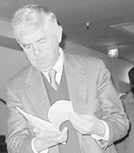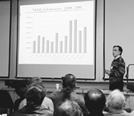Remembering a Peerless Program Manager, Celebrating a Vital Applied Math Sciences Program
May 9, 2001

Family, friends, and colleagues of Fred Howes met in Berkeley in March to commemorate the achievements of the remarkable DOE program manager. The conference, Analysis, Models, and Methods: A Conference on Applied Mathematics and Computational Methods in Memory of Fred Howes, featured 15 speakers, all supported by Howes during his eight years at DOE.
Analysis, Models, and Methods: A Conference on Applied Mathematics and Computational Methods in Memory of Fred Howes, was organized "to highlight the unifying intellectual themes," as well as the mathematical and scientific contributions, of research sponsored by Howes as manager of the Department of Energy's Applied Mathematical Sciences (AMS) Program from 1992 until his death, in December 1999. The organizers were Alexandre Chorin (University of California, Berkeley), Isadore Singer (MIT), and Margaret Wright (Bell Laboratories, Lucent Technologies).
Attending the conference were a diverse group of friends and colleagues of Howes, along with his widow, Mary Hall, a computational meteorologist, and their son, Michael Howes. As a group, the 15 speakers, from universities and national labs, all supported by Howes during his time at DOE, reflected the broad vision that helped make him such a valued colleague for all who spoke.
As invited speaker Bruce Hendrickson of Sandia National Laboratories (Albuquerque) put it, "one of Fred's clear visions" was that his program was the mathematics program of DOE. Given the enormous range of DOE's scientific interests, and the different mathematical needs of each area, "Fred did his best to cover all of it." As reflected in the 15 conference talks, Hendrickson said, the core of the program is numerical PDEs, but with significant support for work in optimization, string theory, discrete mathematics, and biomathematics. (Hendrickson himself, drawn to the boundary, or rather "the deep chasm," between discrete mathematics and scientific computing, devoted his talk to cases in which discrete methods have proved productive in scientific computing, among them graph problems in multigrid, partitioning in domain decomposition, and---his favorite---graph embedding in preconditioning.)
To give readers an idea of the research supported by DOE's AMS program, and of the respect and depth of affection in the community for Fred Howes, a few highlights of the conference are presented here. Fortunately, as MSRI director David Eisenbud pointed out in his welcoming remarks, talks given at MSRI events are videotaped. Thanks to David Hoffman, architect of the streaming video system, and to the cooperative speakers, interested readers can look and listen for themselves (http://www.msri.org/).
Applied Math at DOE: Past, Present, Future
One of Fred Howes's guiding principles was simply to support the best work and the best people, said Dan Hitchcock, who was recently named Senior Technical Adviser for Advanced Scientific Computing Research at DOE. Previously, as acting director of DOE's Mathematical, Information and Computational Sciences Division, he had also taken on the responsibility for the AMS program. Although interested and gratified to learn about all the impressive work being done, Hitchcock pointed out that the program needs a full-time person.

Bob O'Malley, shown here with Mary Hall and Michael Howes, served as master of ceremonies at the conference banquet. Also an invited speaker, he discussed the continuing importance of Howes's early work on the use of differential inequality techniques for singularly perturbed boundary value problems; Howes's work on asymptotic methods for singularly perturbed parabolic PDEs, he pointed out, is related to the subject of his own talk, "Exponential (and Algebraic) Asymptotics for Viscous Shock Equations." Being a deep and thorough scholar, O'Malley said, Howes would have had him make the distinction between exponential and algebraic asymptotics more precisely and reference an obscure 1960 paper by Vishik and Lyusternik; he would also have identified the next step needed: more convincing numerical computations.
"Fred was always scheming" to get mathematicians talking to people doing applications, Hitchcock told the audience. Another of his ever-present priorities was the preparation of the next generation of American mathematicians.
"Scheming" is exactly the right word, said Margaret Wright, thinking of Howes's deep personal commitment to the DOE Computational Science Graduate Fellowship program, which he was determined to keep going even when its funding was in danger. Wright, a long-time member of the CSGF selection and advisory committees, announced at the conference that the first Fred Howes Scholar in Computational Science, to be selected each year from the CSGF Fellows completing their PhDs, will be named this summer. Selection criteria, she explained, will be some of the qualities for which Howes was known: technical excellence, leadership and enthusiasm, and character. The Howes Scholar award was created by donations from Howes's friends and colleagues and a generous gift from Howes's family; the endowment is managed by the Krell Institute (www.krellinst.org).
"Fred was not a cold bureaucrat," said Peter Lax of the Courant Institute; he was not a bureaucrat at all, in fact, but rather "a mathematical scientist who knew his way through the bureaucracy." At the request of the organizers, Lax took some time from his technical talk ("Positive Schemes for Hyperbolic Conservation Laws") to give the audience a glimpse of the early days of DOE's mathematical and computational sciences program (see "Before the Department of Energy There Was ... the Manhattan Project").
PDEs and Beyond
Before the Washington phase of his career (which included a pre-DOE term as a rotator at the National Science Foundation), Howes spent more than ten years at the University of California, Davis. Angela Cheer, one of his UC Davis colleagues, gave a talk (timely, as it turned out, given medical bulletins on the vice president of the U.S.) on flow in cardiovascular systems. Already convinced during his years at Davis that scientific computation would have an impact on biology, Howes had encouraged Cheer to pursue her ideas about biomedical applications.
Cheer's group is working to understand the genesis of atherosclerosis from a fluid dynamics point of view, and to design improved endovascular devices for its treatment. Endovascular stents, which with bypass surgery and angioplasty constitute the current standard treatment methods for many atherosclerotic lesions, are one focus of the group's efforts. Using overset meshes and an interpolation scheme that allows the meshes to talk to each other, the researchers use a finite volume numerical method to approximate the solution to the Navier-Stokes equations. The group is studying the effects of endovascular stents on fluid flow; the stents being studied are now in use in patients, Cheer told the audience, although they haven't been in place long enough for surgeons to provide data on their long-term effects on restenosis.
James Glimm (SUNY Stony Brook) prefaced his talk on chaos and fluid mixing with some thoughts "about the special person that a program manager is---the 'soul' of a subject." A good program manager, he said, can reach into the community and bring out its best, and then project that best onto the larger scientific community. "This is what Fred did."
Envisioning an increasing emphasis among decision makers on prediction and uncertainty of mathematical models, Glimm described a simple model on which he and colleagues have worked: a light fluid in a heavy fluid. Two simulations of basically the same thing---one a sharp-interface model and the other a diffused-interface model---differed by a "disturbing" factor of two. Direct numerical simulations can provide "one window on the truth," he said; a simple statistical model that "gave better results than we deserved" provides another window. "We have many models," Glimm concluded, "but too few validated models."
John Guckenheimer began his talk by describing the DOE applied mathematics programs as "a national treasure---Fred knew what their value was and took a long-term view in the face of political pressures." Guckenheimer pointed out that the subject of his talk, bifurcation in dynamical systems with multiple time scales, was an area in which Howes had worked himself.
Two of the conference organizers, Isadore Singer and Alexandre Chorin, gave technical talks. "Unfailingly far-sighted and constructive," Howes understood the impact of mathematics in all realms---in particular the impact of high-energy theory on geometry, Singer said. In his talk, Singer presented a stimulating vision of the unity between advanced mathematics and frontiers of theoretical physics.

Conference organizer Alexandre Chorin of the University of California, Berkeley, gave a talk on his group's recent work in optimal prediction.
As the last of 15 speakers, Chorin might have been excused for failing to find something different to say about Fred Howes, but he didn't falter. Previous speakers, he pointed out, may have given the impression that Fred was so well liked because he gave everyone what they wanted. But this was not the case: "Fred had definite ideas about what people should and should not do mathematically, but he did it with such charm that no one ever minded."
Chorin presented some of his group's recent work in an area enthusiastically supported by Howes at DOE: predictability. Chorin and his colleagues (mainly Ole Hald, Anton Kast, and Raz Kupferman) focus on large-scale nonlinear problems for which only partial information is available. The accuracy of the solutions that can be obtained is limited by computational resources or by the availability of data.
The group approaches the problem by using prior statistical information and viewing the initial data---point values for solutions or small numbers of Fourier coefficients, for example---as constraints on the set of possible solutions. With nonlinear problems, Chorin said, "things you don't know will mix with the things you do know, and you lose predictability"---this is the essence of the predictability problem. The issue, then, is to develop machinery for constructing solutions that preserve as much of the system's behavior as possible, and for estimating uncertainty (the mean and moments of the possible solutions).
Chorin pointed to Kast's work on a molecular dynamics many-body problem as the best application to date. In response to a question about the optimal applications for the approach, Chorin said that the group was thinking about weather prediction. The real application, he said, will be many-particle systems, for the moment classical; the hope is that it will turn out to apply to quantum systems as well.

Jorge Mor� of Argonne National Laboratory identified various "eras" in optimization, beginning with Bill Davidon's introduction of quasi-Newton methods (in a 1959 Argonne technical report), proceeding through Nelder-Mead direct-search methods, automatic differentiation, and interior-point methods---among others---and ending with today's modeling languages, such as AMPL and GAMS, and algorithms, such as LOQO and SNOPT. Mor� pointed to a novel and increasingly used way to solve optimization problems that was also cited by Jack Dongarra: Develop code for solving the problem and submit it to NEOS. NEOS, developed at Argonne, receives at least 3000 problems a month; users have to provide neither software nor cycles, Mor� explained. What kinds of problems are submitted? One example, from the list of widely ranging problems received to date, is estimation of the risk of financial institutions.Jorge Mor� of Argonne National Laboratory identified various "eras" in optimization, beginning with Bill Davidon's introduction of quasi-Newton methods (in a 1959 Argonne technical report), proceeding through Nelder-Mead direct-search methods, automatic differentiation, and interior-point methods---among others---and ending with today's modeling languages, such as AMPL and GAMS, and algorithms, such as LOQO and SNOPT. Mor� pointed to a novel and increasingly used way to solve optimization problems that was also cited by Jack Dongarra: Develop code for solving the problem and submit it to NEOS. NEOS, developed at Argonne, receives at least 3000 problems a month; users have to provide neither software nor cycles, Mor� explained. What kinds of problems are submitted? One example, from the list of widely ranging problems received to date, is estimation of the risk of financial institutions.
In addition to the speakers mentioned here, the program featured talks by Darryl Holm, Los Alamos National Laboratory; Marsha Berger, Courant Institute; Jack Dongarra, University of Tennessee (see article); Phillip Colella, Lawrence Berkeley National Laboratory; David Brown, Lawrence Livermore National Laboratory; and Barry Smith, Argonne.

